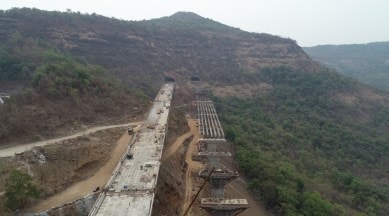Stay updated with the latest - Click here to follow us on Instagram
Load testing on Pune-bound viaduct of ‘Missing link’ project postponed by 2 weeks amid heavy rain
The decision came at a time when on Wednesday Lonavala received 295 mm of rainfall, Monkey Hill saw 302 mm of rain and Karjat received 292 mm of rain.

The first official load testing on the Pune-bound viaduct, which is a part of Mumbai-Pune Corridor’s ‘Missing link’ project, has been postponed by two weeks amid the heavy rain, said an official of the Maharashtra State Road Development Corporation (MSRDC), which is the project implementing authority. The load testing was expected to be done on July 18.
The decision came at a time when on Wednesday Lonavala received 295 mm of rainfall, Monkey Hill saw 302 mm of rain and Karjat received 292 mm of rain.
monthly limit of free stories.
with an Express account.
As per a mandate of the Indian Road Congress, heavy vehicles loaded with murram (mixture of soil, sand, gravel and concrete) and other items were to be run on the Pune-bound viaduct. The MSRDC official said while indirect testing has been done several times, the official load testing is essential.
The official also added that although the viaduct is ready, it cannot be opened for the traffic since the construction of a cable-stayed bridge is yet to be completed. In this project, the construction of the cable-stayed bridge is the most challenging part coming across the Valley at a height of 100 metre. In fact, due to the monsoon showers, the work is becoming more challenging as the portion is a ghat section that sees daily rainfall to the tune of 50-65 mm.
The Rs 6,600-crore worth 13-km-long ‘Missing link’, which is a part of the existing Mumbai Pune Expressway, starts at Khopoli, bypasses the expressway through an 840-metre-long viaduct coming up at a height of 60 metre, enters a 1.75-km-long tunnel, then goes over the 640-metre-long cable-stayed bridge built at a height of 100 metre from Tiger valley at the Lonavala-Khandala section and thereafter enters another 8.9-km-long tunnel. A part of this tunnel lies 170 feet below the ground with the Lonavala lake above it, emerging near the Sinhgad Institute.
Once ready, the missing link will save 20-30 minutes of commute time cutting down almost six kilometre of distance between Khopoli and Sinhgad Institute. More importantly, motorists won’t have to drive through the existing ghats and would be able to move faster at up to 120 kmph.
This project aims to make the Mumbai Pune expressway zero fatality corridor, overcoming the annual worry during the monsoon — traffic gridlocks at Khandala due to falling boulders from hillocks that flank the road.